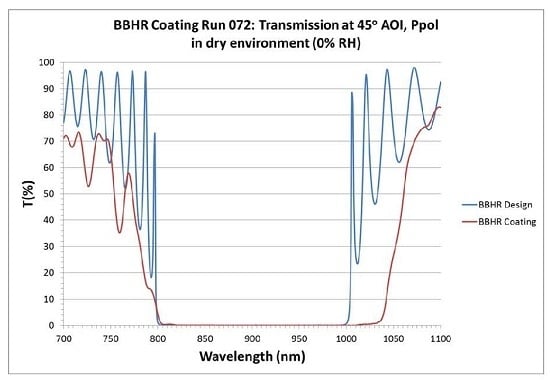Low Group Delay Dispersion Optical Coating for Broad Bandwidth High Reflection at 45° Incidence, P Polarization of Femtosecond Pulses with 900 nm Center Wavelength
Abstract
:1. Introduction
2. Background and Context
3. Challenges in Designing BBHR Coatings for fs Pulses
4. Strategy for Design and Production of the BBHR Coating
4.1. Deposition Conditions and Choice of H and L Index Layer Materials for BBHR
4.2. Exploring Quarter-Wave Type Coating Designs for BBHR
5. BBHR Design Result
5.1. Transmission Spectra for the BBHR Design
5.2. GD and GDD Behaviors for the BBHR Design
5.3. E-Field Intensities for the BBHR Design and Implications for LIDTs
6. Initial Test Coating Run Based on the BBHR Design
7. Subsequent Coating Runs Based on the BBHR Design
8. Summary and Conclusions
Acknowledgments
Author Contributions
Conflicts of Interest
References
- Schwarz, J.; Rambo, P.; Geissel, M.; Edens, A.; Smith, I.; Brambrink, E.; Kimmel, M.; Atherton, B. Activation of the Z-petawatt laser at sandia national laboratories. In Proceedings of The 5th International Conference on Inertial Fusion Sciences and Applications (IFSA2007), Kobe, Japan, 9–14 September 2007; pp. 1–4.
- Rambo, P.K.; Smith, I.C.; Porter, J.L., Jr.; Hurst, M.J.; Speas, C.S.; Adams, R.G.; Garcia, A.J.; Dawson, E.; Thurston, B.D.; Wakefield, C.; et al. Z-Beamlet: A multi-kilojoule, terawatt-class laser system. Appl Opt. 2005, 44, 2421–2430. [Google Scholar] [CrossRef] [PubMed]
- Z-Backlighter Laser Facility, Sandia National Laboratories Homepage. Available online: http://www.z-beamlet.sandia.gov (accessed on 7 March 2016).
- Matzen, M.K.; Atherton, B.W.; Cuneo, M.E.; Donovan, G.L.; Hall, C.A.; Herrmann, M.; Kiefer, M.L.; Leeper, R.J.; Leifeste, G.T.; Long, F.W.; et al. The refurbished Z Facility: Capabilities and recent experiments. Acta Phys. Polonica A 2009, 115, 956–958. [Google Scholar] [CrossRef]
- Z-Accelerator, Sandia National Laboratories Homepage. Available online: http://www.sandia.gov/z-machine/ (accessed on 7 March 2016).
- Bellum, J.; Kletecka, D.; Rambo, P.; Smith, I.; Kimmel, M.; Schwarz, J.; Geissel, M.; Copeland, G.; Atherton, B.; Smith, D.; et al. Meeting thin film design and production challenges for laser damage resistant optical coatings at the Sandia Large Optics Coating Operation. In Proceedings of the 41st Annual Laser Damage Symposium, Laser-Induced Damage in Optical Materials: 2009, Boulder, CO, USA, 21–23 September 2009.
- Bellum, J.; Rambo, P.; Schwarz, J.; Smith, I.; Kimmel, M.; Kletecka, D.; Atherton, B. Production of optical coatings resistant to damage by petawatt class laser pulses. In Lasers—Applications in Science and Industry; Jakubczak, K., Ed.; InTech Open Access Publisher: Rijeka, Croatia, 2011; pp. 23–52. [Google Scholar]
- Baumeister, P.W.; Stone, J.M. Broad-band multilayer film for fabry-perot interferometers. J. Opt. Soc. Am. 1956, 46, 228–229. [Google Scholar] [CrossRef]
- Heavens, O.S.; Liddell, H.M. Staggered broad-band reflecting multilayers. Appl. Opt. 1966, 5, 373–376. [Google Scholar] [CrossRef] [PubMed]
- Pervak, V. Recent development and new ideas in the field of dispersive multilayer optics. Appl. Opt. 2011, 50, C55–C61. [Google Scholar] [CrossRef] [PubMed]
- Szipöcs, R.; Kárpát, F. Chirped multilayer coatings for broadband dispersion control in femtosecond lasers. Opt. Lett. 1994, 19, 201–203. [Google Scholar]
- Oliver, J.; Bromage, J.; Smith, C.; Sadowski, D.; Dorrer, C.; Rigatti, A.L. Plasma-ion-assisted coatings for 15 femtosecond laser systems. Appl. Opt. 2014, 53, A221–A228. [Google Scholar] [CrossRef] [PubMed]
- Macleod, H.A. Thin-Film Optical Filters; Institute of Physics: Bristol and Philadelphia, PA, UK and USA, 2002. [Google Scholar]
- Tikhonravov, A.V.; Trubetskov, M.K. OptiLayer Thin Film Software. Available online: http://www.optilayer.com (accessed on 7 March 2016).
- Bellum, J.; Winstone, T.; Lamaignere, L.; Sozet, M.; Kimmel, M.; Rambo, P.; Field, E.; Kletecka, D. Analysis of laser damage tests on a coating for broad bandwidth high reflection of femtosecond pulses. In Proceedings of Pacific Rim Laser Damage 2015: Optical Materials for High-Power Lasers, Jiading, Shanghai, China, 17–20 May 2015.
- Wollenhaupt, M.; Assion, A.; Baumert, T. Femtosecond laser pulses: linear properties, manipulation, generation and measurement. In Springer Handbook of Lasers and Optics; Träger, F., Ed.; Springer: New York, NY, USA, 2007; pp. 937–983. [Google Scholar]
- Born, M.; Wolf, E. Principles of Optics; Pergamon Press: New York, NY, USA, 1980; Section 7.5.8. [Google Scholar]
- Field, E.S.; Bellum, J.C.; Kletecka, D.E. Laser damage comparisons of broad-bandwidth, high-reflection optical coatings containing TiO2, Nb2O5, or Ta2O5 high index layers. In Proceedings of the 45th Annual Laser Damage Symposium, Laser-Induced Damage in Optical Materials: 2013, Boulder, Colorado, USA, 22–25 September 2013.
- Bellum, J.; Field, E.; Kletecka, D.; Long, F. Reactive ion-assisted deposition of e-beam evaporated titanium for high refractive index TiO2 layers and laser damage resistant, broad bandwidth, high-reflection coatings. Appl. Opt. 2014, 53, A205–A211. [Google Scholar] [CrossRef] [PubMed]
- NIF Technical Report MEL01–013–0D: Small Optics Laser Damage Test Procedure; Lawrence Livermore National Laboratory: Livermore, CA, USA, 2005.
- ISO Standard 11254–1: Lasers and Laser-Related Equipment—Determination of Laser-Damage Threshold of Optical Surfaces—Part 1: 1-on-1 Test; International Organization for Standardization: Geneva, Switzerland, 2000.
- Chromatis Test Instrument, Kapteyn-Murnane Laboratories Homepage. Available online: http: //www.KMLabs.com/content/chromatis (accessed on 7 March 2016).
- Sozet, M.; Néauport, J.; Lavastre, E.; Roquin, N.; Gallais, L.; Lamaignère, L. Laser damage density measurement of optical components in the sub-picosecond regime. Opt. Lett. 2015, 40, 2091–2094. [Google Scholar] [CrossRef] [PubMed]
- ISO Standard 11254–2: Lasers and laser-related equipment—Determination of Laser-induced Damage Threshold of Optical Surfaces —Part 2: S-on-1 Test; International Organization for Standardization: Geneva, Switzerland, 2001.
- Spica Technologies, Inc. Homepage. Available online: http://www.spicatech.com (accessed on 7 March 2016).
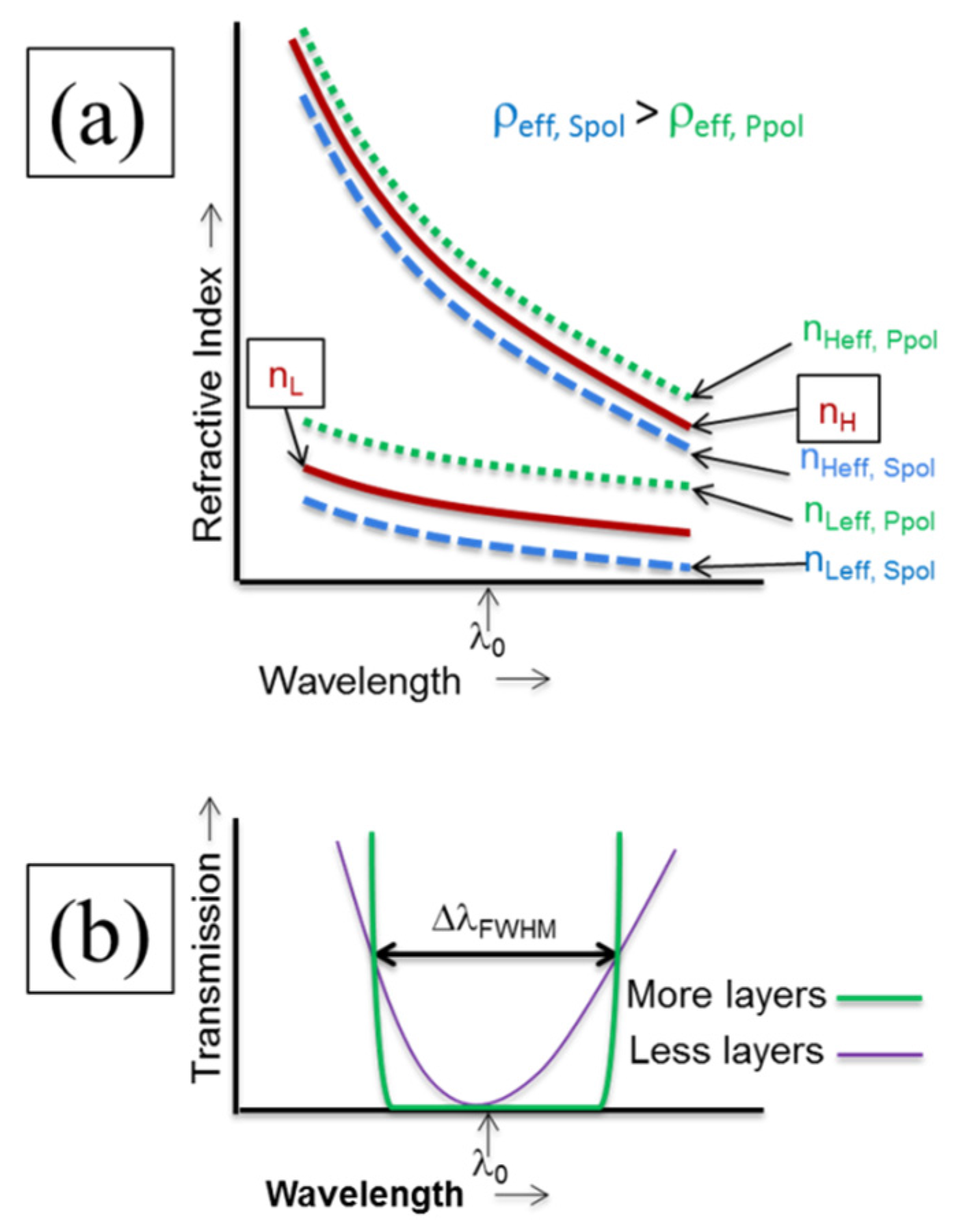

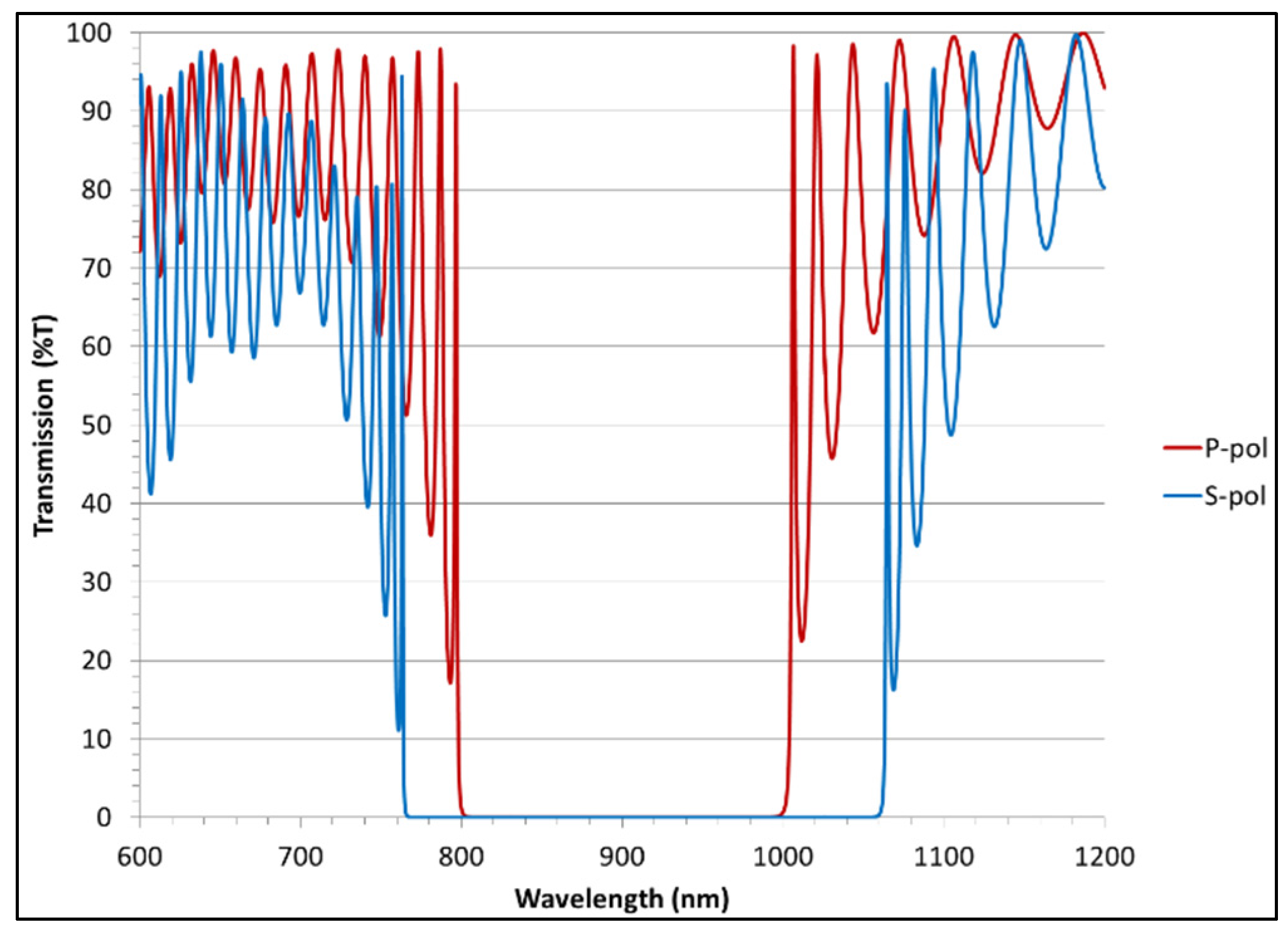

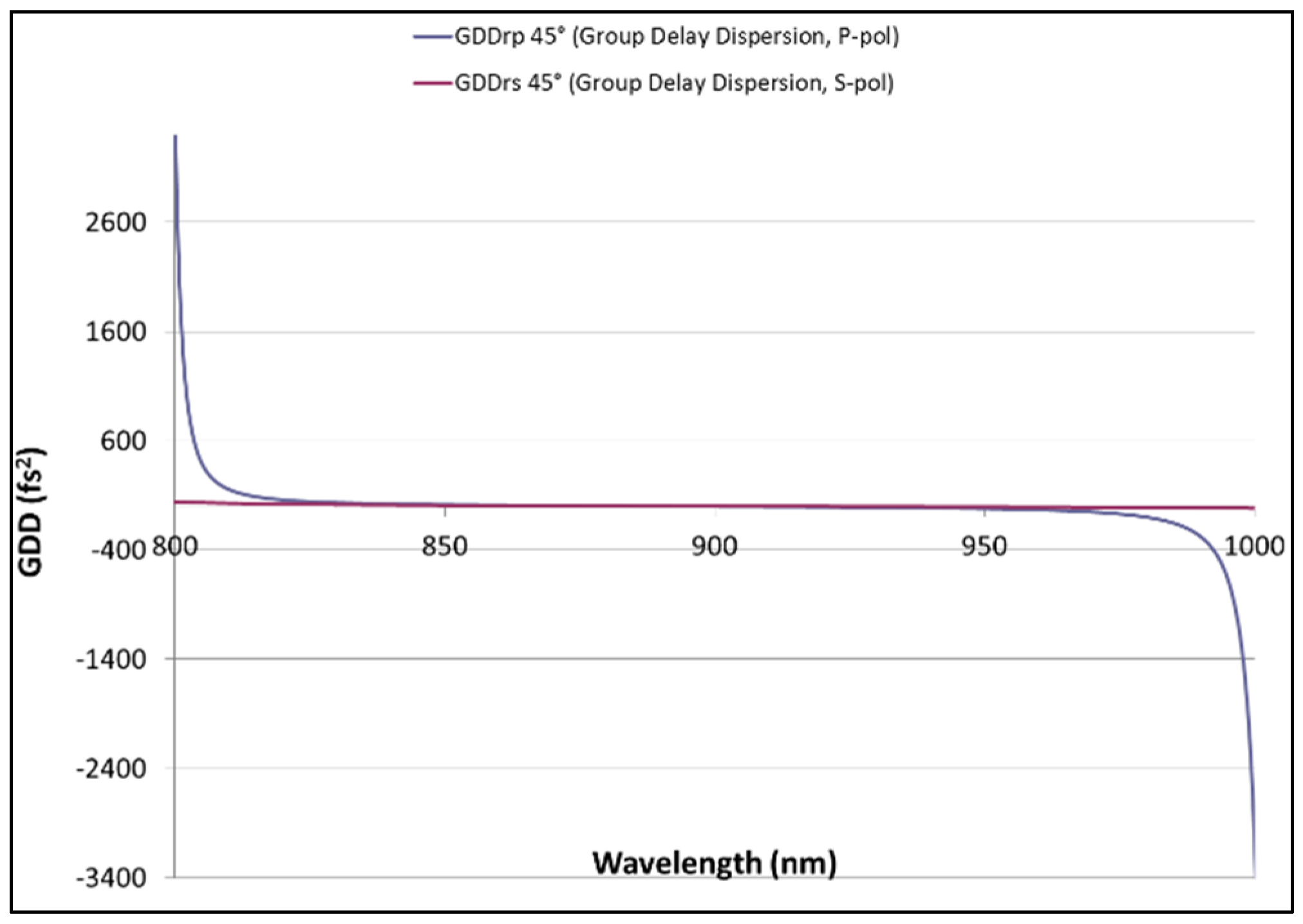
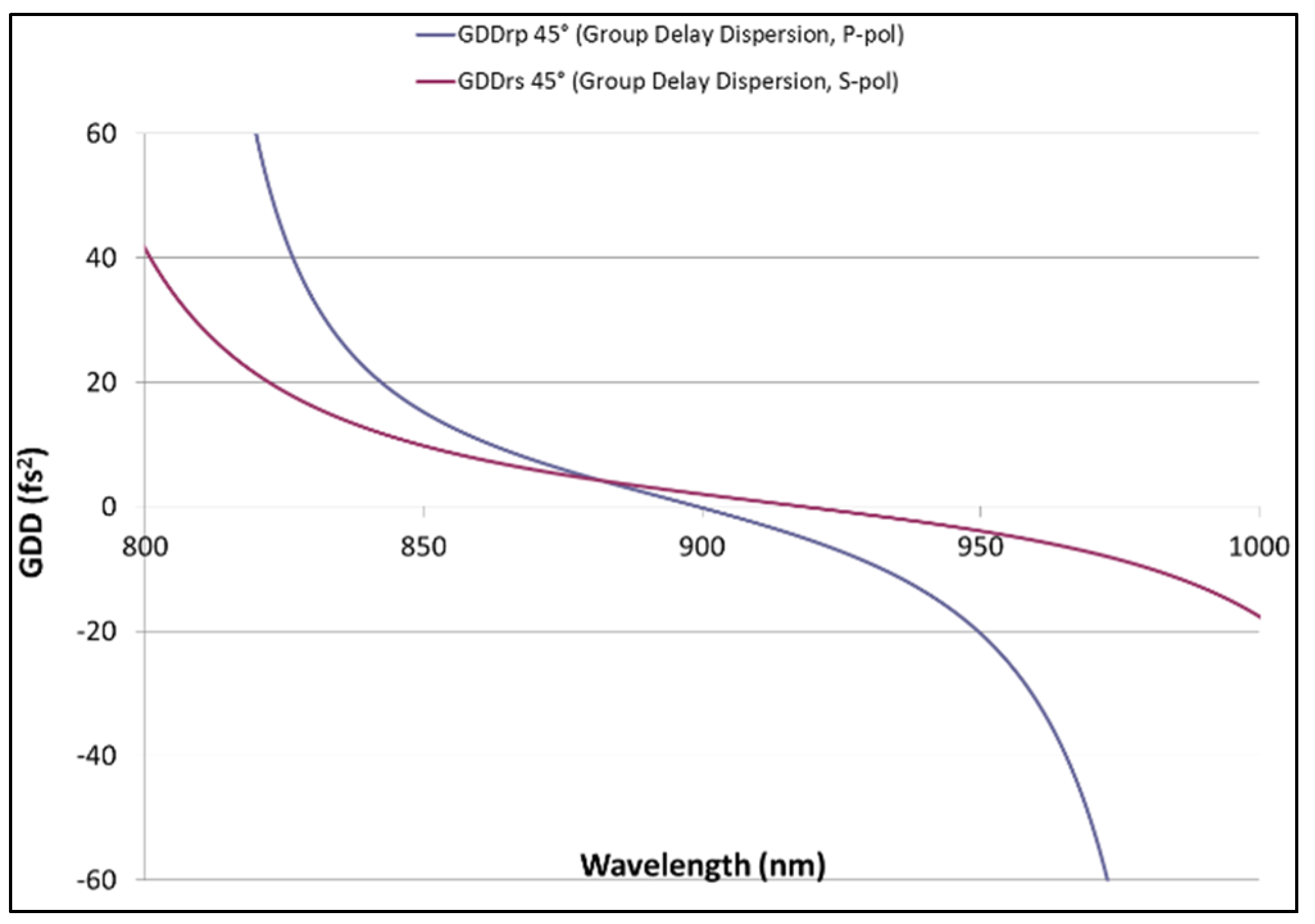
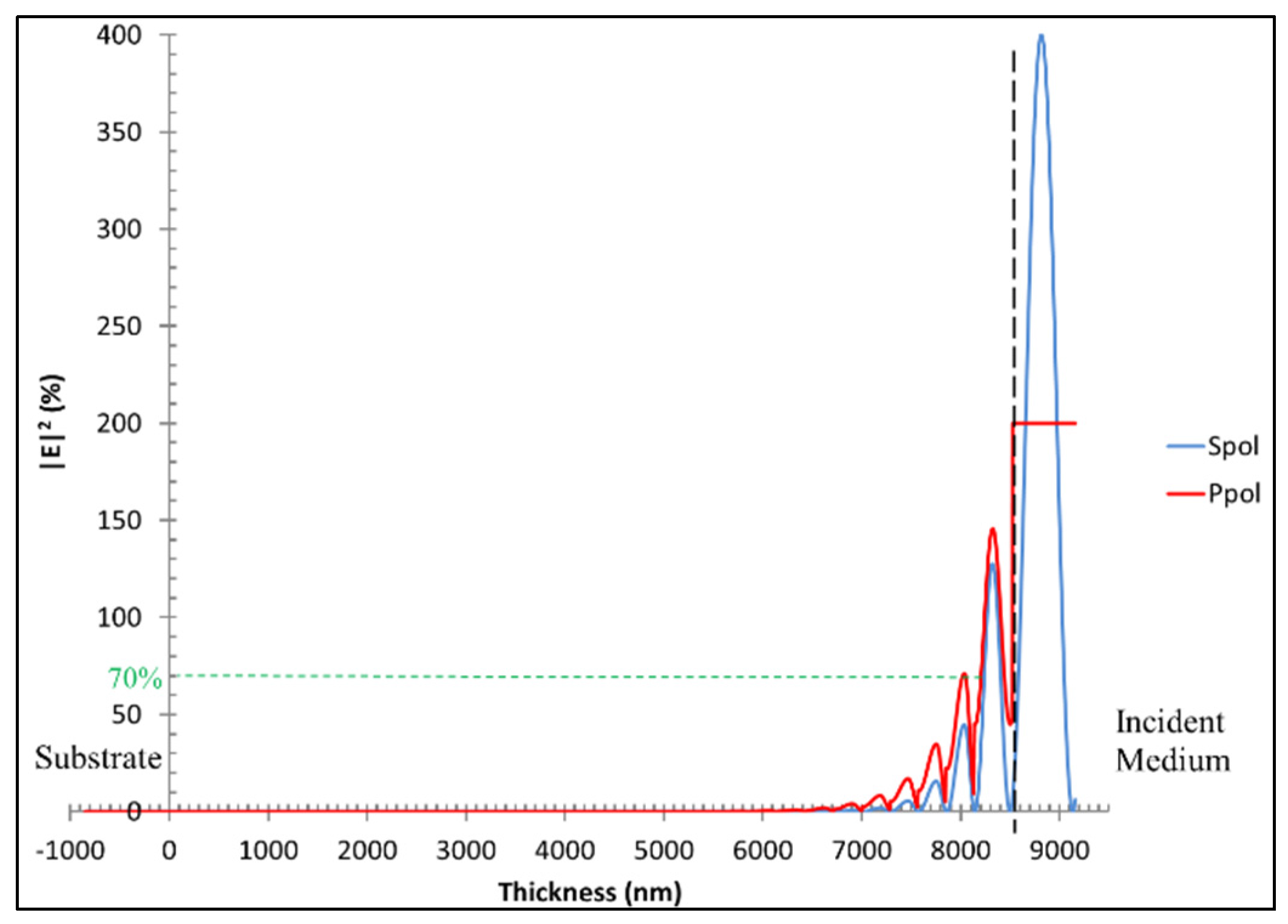

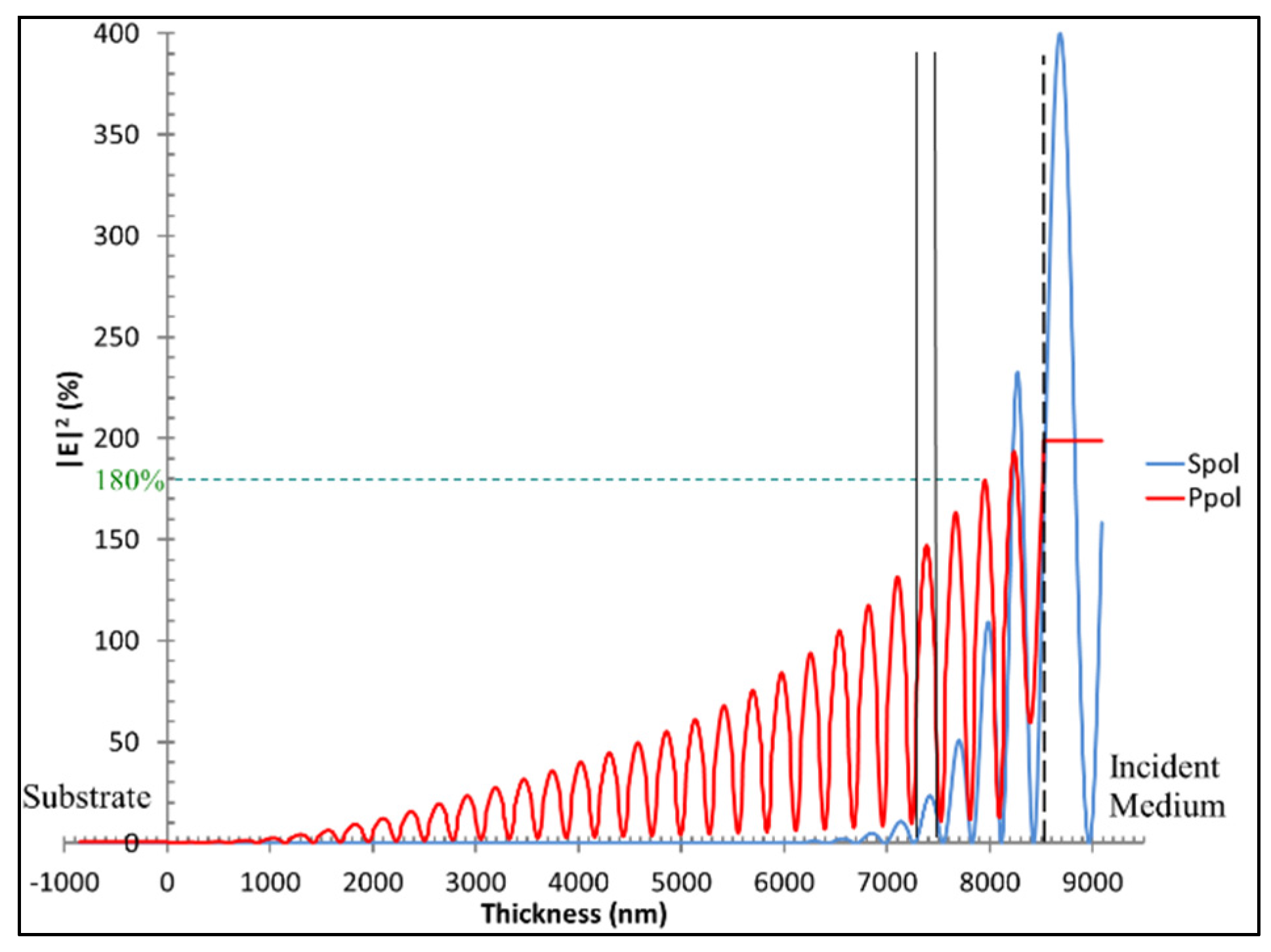


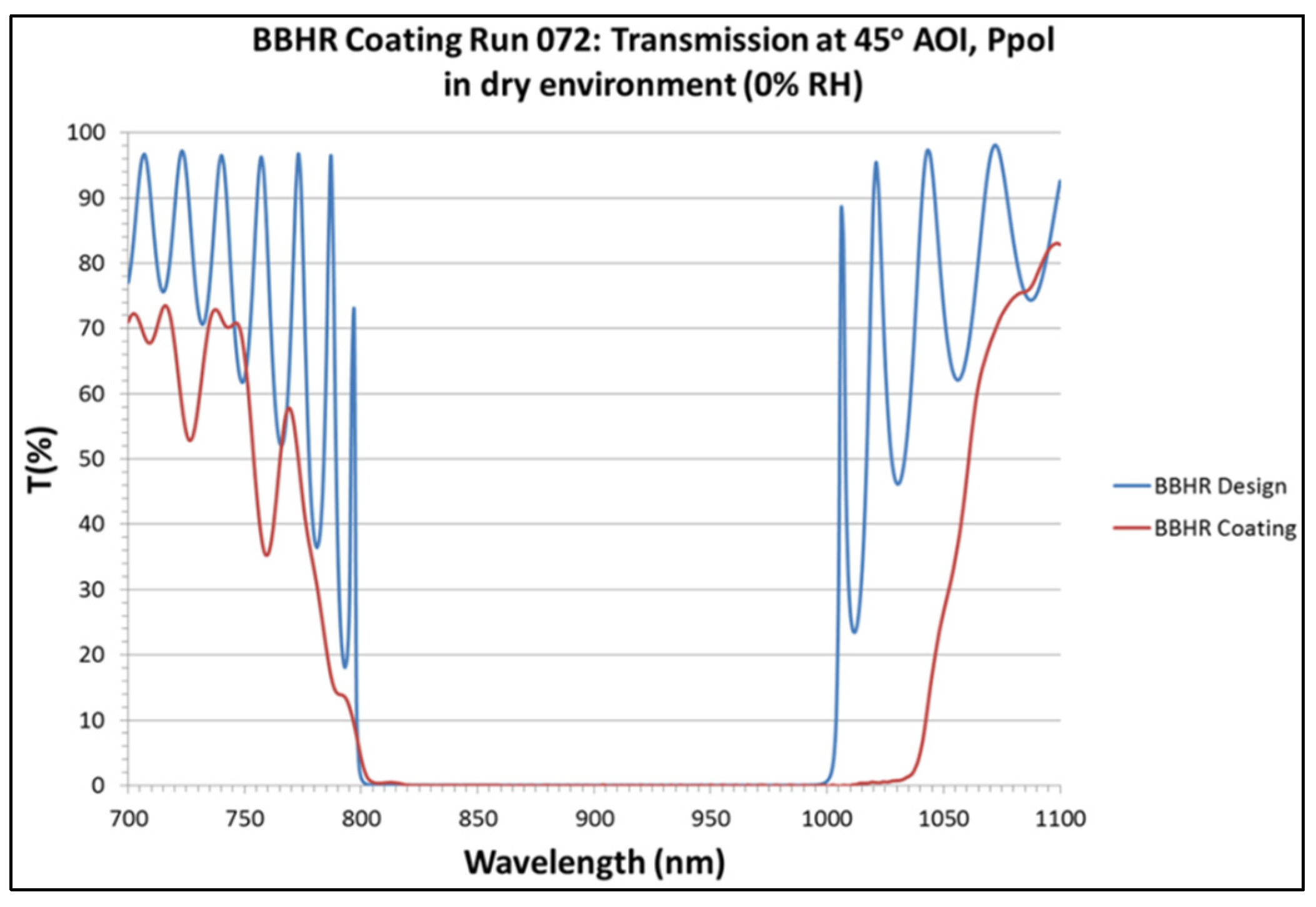
| Reflectivity | Operational Bandwidth | LIDT | GDD |
|---|---|---|---|
| >99.5% for 45° AOI, Ppol | 800–1000 nm | >800 mJ/cm2 for fs-class pulses | <20 fs2 over the operational bandwidth |
| Δτ | Δυ (109 Hz) | Δλ (nm) |
|---|---|---|
| 1 ns | 1 | 0.0027 |
| 100 ps | 10 | 0.027 |
| 10 ps | 100 | 0.27 |
| 1 ps | 1000 | 2.7 |
| 100 fs | 10000 | 27 |
| 10 fs | 100000 | 270 |
| Layer Property | H Index Layers | L Index Layers | ||
|---|---|---|---|---|
| 800 nm | 1000 nm | 800 nm | 1000 nm | |
| layer index | 2.295884 | 2.269580 | 1.457966 | 1.455900 |
| propagation angle in layer | 17.938° | 18.153° | 29.0122° | 29.0573° |
| path in layer | 1.0511 × tH | 1.0524 × tH | 1.1435 × tL | 1.1440 × tL |
| optical path in layer | 2.4132 × tH | 2.3885 × tH | 1.6672 × tL | 1.66555 × tL |
| Thin Film Layer | A0 | A1 | A2 |
|---|---|---|---|
| TiO2 | 2.224101 | 0.044657 | 8.2192065 × 10−4 |
| SiO2 | 1.452228 | 0.003672198 | 3.935249 × 10−8 |
| Coating & BBHR Band (for R > 99.5%) | Test Center Wavelength | Test Pulse Duration | Test AOI | Test Polarization | Test Protocol | LIDT (J/cm2) | LIDT Reference |
|---|---|---|---|---|---|---|---|
| Coating 1 940–1171 nm | 1064 nm | 3.5 ns | 45° | P | NIF-MEL [20] | 28 | [18] |
| Coating 1 940–1171 nm | 1064 nm | 10 ns | 45° | P | ISO 11254-1 [21] (1-on-1) | 17.5 | [18] |
| Coating 2 971–1203 nm | 1064 nm | 3.5 ns | 45° | P | NIF-MEL [20] | 19 | [19] |
| Coating 2 971–1203 nm | 1064 nm | 10 ns | 45° | P | ISO 11254-1 [21] (1-on-1) | 12.7 | [19] |
| Coating, Run 071 819–1108 nm | 1064 nm | 800 ps | 0° | – | NIF-MEL [20] | 11 | [15] |
| Coating, Run 071 819–1108 nm | 1064 nm | 8 ps | 0° | – | NIF-MEL [20] | 1.25 | [15] |
| Coating, Run 071 808–1097 nm | 1064 nm | 800 ps | 19° | P | NIF-MEL [20] | 9 | [15] |
| Coating, Run 071 808–1097 nm | 1064 nm | 8 ps | 19° | P | NIF-MEL [20] | 1.5 | [15] |
| Coating, Run 072 866–1169 nm | 1053 nm | 675 fs | 0° | – | ISO 11254-1 [21] (1-on-1) | 1.34 | [15] |
| Coating, Run 072 866–1169 nm | 1053 nm | 675 fs | 0° | – | ISO 11254-2 [24] (10-on-1) | 1.15 | [15] |
| Coating, Run 072 818–1060 nm | 1053 nm | 675 fs | 40° | P | ISO 11254-1 [21] (1-on-1) | 1.15 | [15] |
| Coating, Run 072 818–1060 nm | 1053 nm | 675 fs | 40° | P | ISO 11254-2 [24] (10-on-1) | 0.8 | [15] |
© 2016 by the authors; licensee MDPI, Basel, Switzerland. This article is an open access article distributed under the terms and conditions of the Creative Commons by Attribution (CC-BY) license (http://creativecommons.org/licenses/by/4.0/).
Share and Cite
Bellum, J.C.; Field, E.S.; Winstone, T.B.; Kletecka, D.E. Low Group Delay Dispersion Optical Coating for Broad Bandwidth High Reflection at 45° Incidence, P Polarization of Femtosecond Pulses with 900 nm Center Wavelength. Coatings 2016, 6, 11. https://doi.org/10.3390/coatings6010011
Bellum JC, Field ES, Winstone TB, Kletecka DE. Low Group Delay Dispersion Optical Coating for Broad Bandwidth High Reflection at 45° Incidence, P Polarization of Femtosecond Pulses with 900 nm Center Wavelength. Coatings. 2016; 6(1):11. https://doi.org/10.3390/coatings6010011
Chicago/Turabian StyleBellum, John C., Ella S. Field, Trevor B. Winstone, and Damon E. Kletecka. 2016. "Low Group Delay Dispersion Optical Coating for Broad Bandwidth High Reflection at 45° Incidence, P Polarization of Femtosecond Pulses with 900 nm Center Wavelength" Coatings 6, no. 1: 11. https://doi.org/10.3390/coatings6010011
APA StyleBellum, J. C., Field, E. S., Winstone, T. B., & Kletecka, D. E. (2016). Low Group Delay Dispersion Optical Coating for Broad Bandwidth High Reflection at 45° Incidence, P Polarization of Femtosecond Pulses with 900 nm Center Wavelength. Coatings, 6(1), 11. https://doi.org/10.3390/coatings6010011




